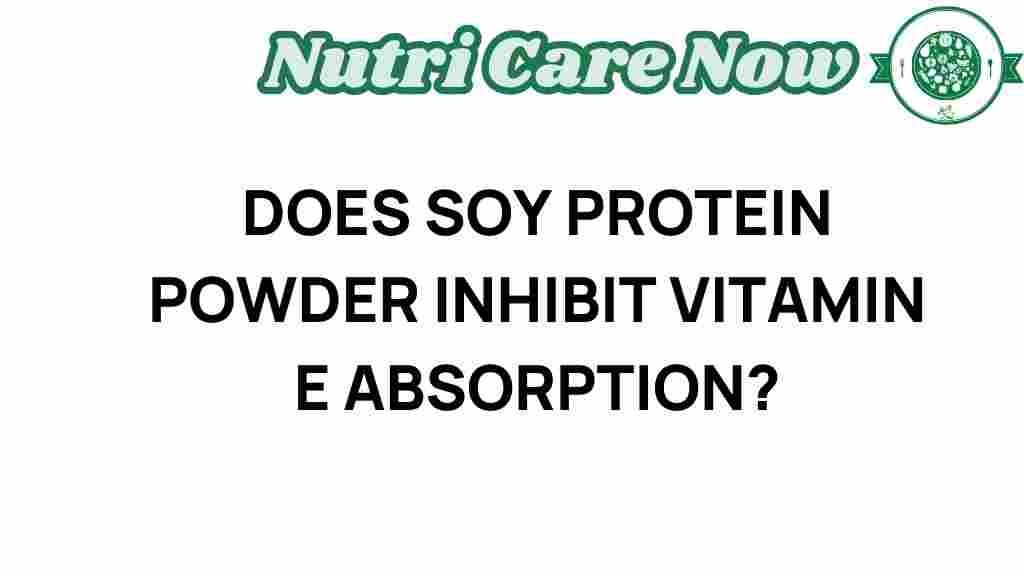Unpacking the Soy Protein Puzzle: Does It Hinder Vitamin E Absorption?
Soy protein has gained significant attention in the nutrition world, particularly for its health benefits and role as a plant-based protein source. However, a common question arises among health enthusiasts and researchers alike: does soy protein hinder the absorption of vitamin E? This article delves into the relationship between soy protein and vitamin E absorption, exploring how these components interact within our diets and their implications for overall health.
Understanding Soy Protein
Soy protein is derived from soybeans and is renowned for its high-quality protein content. It is a complete protein, meaning it contains all nine essential amino acids necessary for human health. This makes it a popular choice among vegetarians and vegans. Here are some key points about soy protein:
- High Biological Value: Soy protein has a high biological value, which means it is efficiently utilized by the body for growth and repair.
- Health Benefits: Regular consumption of soy protein is associated with various health benefits, including improved heart health, reduced cholesterol levels, and potential anti-cancer properties.
- Dietary Supplements: Soy protein is commonly found in dietary supplements, protein powders, and meat alternatives.
The Importance of Vitamin E
Vitamin E is a fat-soluble antioxidant that plays a crucial role in protecting cells from oxidative stress. Here’s why vitamin E is essential:
- Antioxidant Properties: Vitamin E helps neutralize free radicals, reducing oxidative damage in the body.
- Immune Function: It supports the immune system, enhancing the body’s ability to fight infections.
- Skin Health: Vitamin E contributes to healthy skin by protecting against UV damage and improving moisture retention.
The Interaction Between Soy Protein and Vitamin E Absorption
The concern regarding soy protein potentially hindering vitamin E absorption stems from the presence of certain compounds in soy known as phytates and isoflavones. These compounds may influence how the body absorbs various nutrients, including vitamins and minerals.
Phytates and Isoflavones
Phytates are known to bind minerals like calcium, iron, and zinc, potentially affecting their absorption. Isoflavones, which are a type of phytoestrogen found in soy, have been studied for their various health effects. However, their impact on vitamin E absorption is less clear.
How Soy Protein May Affect Vitamin E Absorption
Research on the interaction between soy protein and vitamin E absorption presents mixed findings. Some studies suggest that high soy protein intake might reduce the bioavailability of vitamin E, while others indicate that it does not significantly affect absorption.
- Potential Binding: Some components in soy may bind to vitamin E, making it less available for absorption.
- Dietary Context: The overall diet, including the presence of fats, can significantly influence vitamin E absorption. A diet rich in healthy fats may enhance vitamin E absorption, potentially mitigating any hindering effects of soy protein.
Nutrition and Dietary Considerations
When considering soy protein and vitamin E in your diet, it’s essential to look at the broader context of nutrition:
- Diverse Diet: Consuming a varied diet rich in fruits, vegetables, whole grains, and healthy fats can help ensure adequate vitamin E intake.
- Supplementing Wisely: If you rely heavily on soy protein supplements, consider pairing them with foods high in vitamin E, such as nuts, seeds, and leafy greens.
- Consulting Professionals: If you have concerns about nutrient absorption, consulting with a healthcare professional or nutritionist can provide personalized guidance.
Step-by-Step Process for Optimizing Nutrient Absorption
To maximize the absorption of vitamin E while including soy protein in your diet, consider the following steps:
- Include Healthy Fats: Incorporate healthy fats into your meals, such as avocados, olive oil, or nuts, to enhance the absorption of vitamin E.
- Balance Your Diet: Aim for a balanced diet that includes a variety of protein sources, including legumes, nuts, seeds, and whole grains.
- Timing Matters: Consider consuming vitamin E-rich foods alongside your soy protein sources to improve absorption.
- Stay Informed: Keep up with the latest research on nutrition to understand how different foods interact and affect health.
Troubleshooting Tips
If you are concerned about the absorption of vitamin E while consuming soy protein, here are some troubleshooting tips:
- Monitor Symptoms: Pay attention to any symptoms of vitamin E deficiency, such as muscle weakness or vision problems, and consult a healthcare professional if necessary.
- Adjust Portions: If you consume large amounts of soy protein, consider adjusting your portions to see if it makes a difference in your overall nutrient absorption.
- Explore Alternatives: If you suspect soy is affecting your nutrient absorption, try incorporating other plant-based protein sources, such as lentils, chickpeas, or quinoa.
Conclusion
In conclusion, the relationship between soy protein and vitamin E absorption is complex and still under investigation. While some components in soy may theoretically hinder vitamin E absorption, the overall impact appears to be influenced by dietary context and individual health factors. To reap the health benefits of both soy protein and vitamin E, focus on a well-balanced diet that includes a variety of nutrient-dense foods. For more information on optimizing your nutrient intake and understanding the science behind food, consider exploring resources from reputable nutrition organizations here.
Ultimately, maintaining a holistic approach to your nutrition will help ensure you enjoy the benefits of both soy protein and vitamin E without compromising your health.
This article is in the category Health and created by NutriCareNow Team

3 thoughts on “Unpacking the Soy Protein Puzzle: Does It Hinder Vitamin E Absorption?”